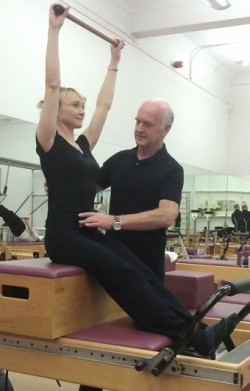Explaining the Method
 You are taught to align your body perfectly before starting an exercise, and then to focus on individual muscle groups and work them without putting strain on other areas. If you are used to the pumping rhythm of an aerobics class or the ache in your muscles after lifting weights, you will be astonished by the gentleness of Pilates. The exercises are deceptively simple, even minimal, and so effective that you needn’t perform more than ten repetitions of each at a session.
You are taught to align your body perfectly before starting an exercise, and then to focus on individual muscle groups and work them without putting strain on other areas. If you are used to the pumping rhythm of an aerobics class or the ache in your muscles after lifting weights, you will be astonished by the gentleness of Pilates. The exercises are deceptively simple, even minimal, and so effective that you needn’t perform more than ten repetitions of each at a session.
Within weeks of starting you will notice that your stomach is flatter. Your muscles will feel more toned and your joints will be looser and more supple. Some people even claim to get taller as their spine is stretched and straightened. Your posture in everyday life will improve as you strengthen the body’s central core muscles, helping you to stand straight and hold your upper body correctly.
Those with back problems will learn to build up their weaker muscles while protecting the spine and relieving strain on injured areas. Once you understand why you have been suffering back pain, and that postural misalignments have been contributing to your problem, you will have the tools to alleviate and prevent any future trouble yourself. Those who are already fit will discover new and effective ways of exercising and toning their bodies.
Pilates requires total concentration, as you breathe to enhance the effectiveness of the movements and focus on the feelings in your muscles. Joseph Pilates liked to quote Schiller: “It is the mind itself which builds the body”. Others have called Pilates “the thinking person’s exercise system”, because you learn how your body works and what you need to do to keep yourself healthy.

